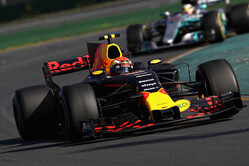 Mercedes insists that season-opener didn't give an accurate picture of overtaking following 2017 rule changes.
Mercedes insists that season-opener didn't give an accurate picture of overtaking following 2017 rule changes.
One race into an all-new era of F1 and debate around the success of the 2017 regulations already rages. Melbourne featured a tense battle between Sebastian and Lewis for the win - but a lack of overtaking throughout the field prompted questions about Formula One's new regulations. Was this indicative of things to come, or just a one-off? The answer is a bit of both.
The Melbourne Grand Prix Circuit has never been great for overtaking. If you go back to the last Australian Grand Prix run under a stable set of regulations, without any major incidents or too many cars starting out of position, you will find precious few passing manoeuvres to note. 2015 featured 13 overtakes - 10 of which were completed using DRS. 2014 was a similar story, with 24 total overtakes - eight with the help of DRS.
Yes, this year's Australian Grand Prix featured only 12 changes of position - including two "normal" overtakes and three overtakes with the assistance of DRS. But the variability year-on-year at this event can be significant. In 2016, a race with a red flag, three Safety Car appearances and plenty of cars starting out of position featured 40 changes of position on track. 2017, by contrast, saw none of these factors, with cars qualifying pretty much as expected and performance differentials throughout the field not sufficient to make changes of position an inevitability.
Traditional passing opportunities aside, a secondary factor came into play in Melbourne. There simply wasn't enough degradation from the new 2017 Pirelli rubber to promote overtaking. Performance differentials become greater when tyres begin dropping off at different rates and this didn't happen at Albert Park.
So the 2017 level of overtaking in Melbourne was low by any measure. However, it would not be right to take the season-opener as a definitive example for the rest of the campaign.
Looking ahead to China, the amount of overtaking in recent years has been significantly different. 2016 saw a whopping 181 passing manoeuvres. Some even argued that Shanghai produced a "fake race" last year owing to the number of changes of position. Cars simply needed to sit in the DRS window and then they came through on the long back straight.
While that number might be tough to match in more straightforward circumstances (last year's race featured a chaotic first lap, an early Safety Car and Lewis' charge from the back), the 28 overtakes from the 2015 edition should be a sensible target. This is the first time we will see what F1 2017 is really made of.
From what we have observed so far, there are factors that will actually make overtaking easier this year. The magnitude of the tow effect is stronger in 2017 thanks to the revised regulations. Bigger cars equal greater wake. When the cars are charging down the straights, there will be an accentuated difference in speed when they enter the overtaking zone. The DRS effect too, is stronger. Thanks in part to the larger rear wings the lap time benefit of DRS has increased over 30%. This again will promote overtaking - especially at tracks with long straights like China and Bahrain.
Furthermore, there's one key learning from Melbourne that has largely been overlooked. Sebastian Vettel was able to stick with Lewis throughout the first stint. Had he spent 16 laps tucked up behind the gearbox of another competitor in previous years, he would have ruined his tyres. Attack, and the rubber would have gone off very quickly. In this race, however, he was able to stay in the wake of Lewis' car relatively comfortably and then push once he had clean air, ultimately taking the lead and the eventual win. That bodes well for closer pack racing this year.
After complaints that DRS has made overtaking too easy in Formula One, we'll now see overtaking as a real game of risk. Drivers are going to have to be brave on the brakes, look after the car and hold onto it. If you're going to overtake in this new era, you need to fight for it properly. That's the way it should be. Perhaps it's too early to write off F1 2017 just yet...






















sign in